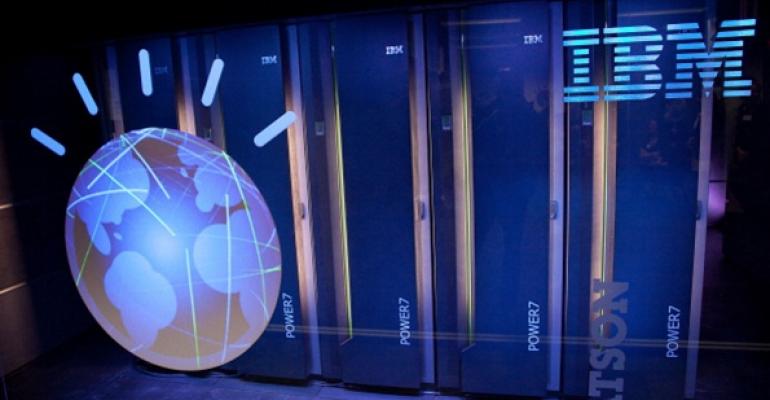 This post is part of the Reporter's Notebook blog.
This post is part of the Reporter's Notebook blog.
The restaurant hostess of the future may be visiting tables via “telepresence robot” like the Beam, which can walk and talk, but has no hands — sort of like Skype on wheels.
Or a sleek, voice-activated, cylindrical computer, like Amazon Echo’s Alexis, could sit on a tabletop and give advice about wine pairings or the day’s specials. It would be like dining with Hal from the movie “2001: A Space Odyssey,” but hopefully without the malevolent streak.
And, of course, there may be drones delivering dinner.
These and other innovations exist now and could change the face of the hospitality industry in the future as restaurants increasingly become technology companies.

A delivery drone appears at the NRA's Restaurant Innovation Summit. Photo: Lisa Jennings
This was a running theme at a National Restaurant Association Restaurant Innovation Summit in San Diego last week, where attendees also witnessed IBM Watson’s latest iteration as “Chef Watson,” applying its cognitive superpowers to recipe development.
Josh Halpern, Anheuser-Busch vice president of national retail sales, demonstrated self-service beer tap technology that checks IDs and allows customers to pay by the ounce. Next up: Smart vending machines in hotels that will serve beer on draft, eliminating the need for those exhausting trips to the lobby bar.
Whether consumer-facing or behind the scenes, technology is increasingly become a tool for disruption within the hospitality industry.
Such change, however, brings with it a new way of thinking, said Amy Webb, founder and CEO of the digital strategy consulting firm Webbmedia Group.
Webb outlined five digital trends that will help restaurant operators think about tech innovations in a new light:
Digital time zones. We tend to think of time chronologically, but Webb sees consumers using their digital tools and playthings in three new “zones”: “me time,” “our time,” and “real time.”
“Me time” is when consumers are interacting with their device as a personal experience. That’s when it’s just a person and his or her smartphone in a “Calgon, take me away!” moment, playing a game or watching a cat video.
That’s different from “our time,” when consumers use their devices with other people to solve a problem, play or work. The device isn’t a wall, but actually facilitates conversation, Webb said.
In “real time,” devices do something immediate for consumers, like pagers that let them know their table is ready, or apps that allow them to remotely get in line at their favorite restaurant.
As they develop technology, restaurant operators should think about how they can accommodate more than one digital time zone. For example, could tabletop tablets offer “me time” entertainments in addition to “our time” ordering?
“Start thinking about digital time zones, focusing on your customers’ needs and behaviors, rather than just their devices and your organization’s workflow,” she said.
Ambient attendants. Restaurant operators have long tried to anticipate customer needs even before they know what they need. Now virtual technology is increasingly incorporating that responsive function into features with tools that give users notifications that are actionable even before they know to ask.
Google Now, for example, will send an alert to you to leave your house earlier if there’s traffic along your usual commuter route. The restaurant chatbot Luka is being designed to give advice on dining out, but in a way that feels more like a conversation, sifting through reviews that would fit your specific tastes.
Webb called it the “autocomplete for our intentions,” a trend that will likely be invisible, but eventually ubiquitous.
“It’s still far off,” she said, “but it’s time to start thinking about how to incorporate these tools now.”
Recognition. Facial recognition technology can increasingly pick a stranger out of a crowd, identify them, then tap public databases to find out all sorts of things about their lives.
Some apps can now also identify people by the way they type, like identifying handwriting. “Thermal fingerprinting” uses heat mapping to identify people, even if their face is covered, Webb said.
Creepy? Maybe.
But Webb contends it’s a tool restaurant operators could harness. Compliance officers may be concerned about privacy, but the information available is public and legally accessible, she said.
Cognitive computing. IBM in particular is doing a lot of work in this space, Webb said. Computers are increasingly able to develop “personality insights” on someone based on a snippet of text they write.
If a restaurant operator gets an angry email, for example, that text could be run through the system to create a profile of the writer, which would give the restaurant operator a better idea of how to respond effectively.
“It’s like a spell check, but for personality,” Webb said. “It could review your response and tell you how to tweak it to make sure it’s positively received.”
Participatory dining. In the old days, people went out because of FOMO, Fear Of Missing Out. Today, Millennials have FOGO, or Fear Of Going Out, because they’re afraid to miss out on something happening online.
Increasingly, consumers are being pulled into collective Internet events that must be watched live, and live-streaming apps like Periscope are growing in acceptance.
Such events create a sense of intimacy or special access among viewers, Webb said. Restaurants could harness that to take customers on kitchen tours, for example, or use telepresence robots like Beam to have celebrities remotely visit customers in the dining room.
Webb predicted telepresence, like the Beam, to be a big part of the “robot-assisted restaurant” in the future.
“A lot of people think this is a gimmick,” she said. “I’m telling you that it’s not.”
Contact Lisa Jennings at [email protected].
Follow her on Twitter: @livetodineout




